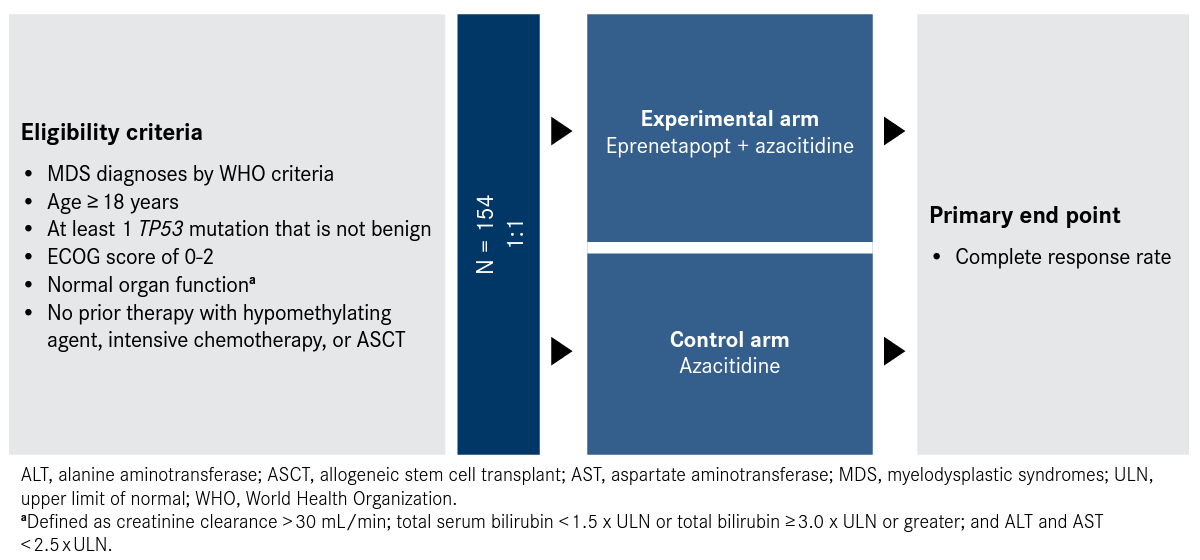Publication
Article
Oncology Live®
Eprenetapopt May Develop Into New Option for TP53-Mutant MDS
Author(s):
The addition of the experimental small molecule eprenetapopt to a standard treatment for myelodysplastic syndromes is showing promise in patients with TP53 mutations.
David Sallman, MD, PhD

The addition of the experimental small molecule eprenetapopt (APR-246) to a standard treatment for myelodysplastic syndromes (MDS) is showing promise in patients with TP53 mutations, a population that often experiences poor responses to therapy and a high risk of disease progression.1,2
Investigators are testing the combination of eprenetapopt plus azacitidine, a hypomethylating agent, compared with azacitidine alone in patients with TP53 mutations in a phase 3 trial (NCT03745716) (Figure).3
Results are expected by the end of 2020 and will be incorporated into new drug applications to the FDA and the European Medicines Agency in 2021, according to Aprea Therapeutics, the company developing the drug.4
Fully enrolled as of June 3, 2020, the trial involves 154 patients in 28 study locations. Participants are expected to receive treatment for an average of 1 year. Results will be stratified by patients’ age (< 65 vs ≥ 65 years). The primary end point is complete response (CR) rate, defined as the proportion of patients who achieve complete remission and duration of CR.
“This is a group that has no good alternatives or good standard of care,” said David Sallman, MD, PhD, principal investigator and assistant member in the Department of Malignant Hematology, Moffitt Cancer Center in Tampa, Florida. “For example, it’s common for patients with TP53 mutations to have the therapy-related disease.”
Demonstrating complete remission is a challenging goal based on the 2006 International Working Group criteria, Sallman added.
“Not only do you need blast clearance, which would be the same across myeloid diseases, but you need full count recovery, which means a neutrophil count higher than 1000, a platelet count higher than 100,000, and a hemoglobin [level] higher than 11 g/dL,” Sallman said.
However, he said this is an important measure especially for patients who do not do well on standard therapy.
“We and others have shown that complete remission in high-risk MDS is the best biomarker for improvement of overall survival. If the primary endpoint is met, this would support approval of this agent as the first TP53-MDS specific therapy,” he noted.
The study has an open-label design, Sallman said, because the therapies are administered differently. Eprenetapopt is given by infusion over 6 hours over the course of 4 days, whereas azacitidine is given as either a subcutaneous injection or an intravenous infusion.
Figure. Eprenetapopt Plus Azacitidine in TP53-Mutant Myelodysplastic Syndromes Phase 3 Trial3

Role of Mutant TP53
Overall, TP53 mutations have been observed in an estimated 5% to 10% of patients with de novo MDS/acute myeloid leukemia (AML), which may evolve from MDS, and increase to 25% to 40% of therapy-related MDS/AML. Additionally, these mutations have been identified in 50% of patients with complex karyotypes and in 20% of those with lower-risk MDS with isolated deletion of chromosome 5q.1
The presence of the TP53 mutation has been associated with poor or short responses to intensive chemotherapy, hypomethylating agents, and allogeneic stem cell transplant, according to Thomas Cluzeau, MD, PhD, who presented key findings about eprenetapopt at the 2020 European Hematology Association Virtual Congress in June.1
He heads the Hematology Department at Central University Hospital of Nice in France.
TP53 functions as a tumor suppressor gene that, when dysregulated, diminishes antitumor activity and promotes cancer cell growth.
When administered, eprenetapopt is converted into methylene quinuclidinone, which binds to p53 proteins, helping to stabilize and reactivate the protein, according to Aprea Therapeutics.
In vitro and in vivo tests show this response to oxidative stress helps to induce apoptosis.5
Results from Earlier Studies
The rationale for combining eprenetapopt and azacitidine in patients with TP53-mutant MDS has been established in findings from 2 early-phase trials conducted in the United States and France.6
In a phase 1b/2 study (NCT03072043), the combination was evaluated in 55 patients: 40 had MDS; 11 had AML with myelodysplasia-related changes, and 4 had chronic myelomonocytic leukemia/MDS-myeloproliferative neoplasms.
Overall, the combination was well-tolerated with high response rates in both MDS and AML, Sallman and colleagues said in presenting the results at the 2019 American Society of Hematology Annual Meeting.7
After a median follow-up of 10.5 months, the overall response rate (ORR) was 87%, including a 53% CR rate. Among those with MDS, the CR rate was 61%. Median time to response for the entire population was 2.1 months. In the intention-to-treat (ITT) population, median overall survival (OS) was 11.6 months (95% CI, 9.2-14.0) with significantly longer OS in responding patients (12.8 vs 3.9 months; P < .0001).7
These outcomes compare favorably to CR rates of approximately 20% and a median OS of 7 to 8 months typically seen in this population with standard-of-care hypomethylating agents, investigators indicated.7
Treatment-related adverse effects (AEs) included nausea/vomiting (58%), dizziness (31%), constipation (24%), neuropathy (22%), leukopenia (22%), and thrombocytopenia (20%). All were grade 1 or 2, except for cytopenias. Treatment-related febrile neutropenia occurred in 9% of patients and anemia occurred 5% of patients.7
No patient discontinued therapy because of treatment-related AEs, Sallman said, adding that the more severe AEs seen are what would normally occur with azacitidine alone. “The only unique toxicity is a neurological change that occurs during the infusion, which includes a tremor, altered sensation, or unsteadiness, but that resolves after the completion of the infusion,” he said.
The phase 2 French study (NCT03588078), conducted by Groupe Francophone des Myélodysplasies, enrolled patients with TP53-mutated MDS or AML who were treated with the eprenetapopt plus azacitidine combination.1
Participants received 4500 mg/day of intravenous eprenetapopt over 6 hours on days 1 to 4 and 75 mg/m2 of subcutaneous azacitidine on days 4 to 10 every 28 days for 6 cycles Patients who responded to the combination continued on therapy until relapse. Patients were recommended for allogeneic stem cell transplant, if appropriate, after 3 to 6 cycles of study therapy and were eligible afterward for continued therapy at reduced doses. In the ITT population, the ORR was 62% among patients with MDS (n = 34), including a 47% CR rate; 64% among those with AML with 20% to 30% blasts (n = 11), including a 27% CR rate; and 29% for those with AML with greater than 30% blasts (n = 7), with no CRs.1
Among evaluable patients who received at least 3 cycles of therapy and had a marrow evaluation after 3 cycles, the ORR was 75% in the MDS cohort (n = 28) with a 57% CR; 78% for the AML 20% to 30% blast group (n = 9), with a 33% CR; and 100% in the AML over 30% blast group (n = 2), with no CRs.
In the ITT population, the median OS was 12.1 months (95% CI, 8.9-15.3) for both the entire group (n = 52) and for the MDS cohort after a median follow-up of 9.7 months. Median OS was 13.0 months (95% CI, 5.4-22.5) for the AML 20% to 30% blast group and 3.0 months (95% CI, 0-6.5) for those with greater than 30 blasts.
For patients who remained on treatment for 3 or more cycles, the median OS was higher at 13.7 months (95% CI, 11.7-15.7) versus 2.8 months (95% CI, 1.2-4.4) for patients who were on treatment for fewer than 3 cycles (P < .0001).1
Overall, all-grade AEs included febrile neutropenia in 19 patients (37%), and 21 patients (40%) experienced neurological AEs, including ataxia (n = 13) cognitive impairment (n = 4), acute confusion (n = 4), isolated dizziness (n = 3), and facial paresthesia (n = 1).
Future Development
Eprenetapopt has received breakthrough therapy, orphan drug, and fast track designations from the FDA for MDS, as well as orphan drug status from the European Union for MDS, AML, and ovarian cancer.4
In addition to the pivotal MDS study, Aprea Therapeutics is sponsoring a phase 2 trial (NCT03931291) assessing eprenetapopt plus azacitidine in patients with TP53-mutant MDS or AML who have received an allogeneic stem cell transplant to evaluate the regimen as posttransplant maintenance therapy. The study, which has a target enrollment of 31 patients, has a primary endpoint of relapse-free survival at 12 months.8
Other ongoing trials include a phase 1 study testing eprenetapopt plus azacitidine and venetoclax (Venclexta) in TP53-mutant myeloid malignancies (NCT04214860) and a phase 1/2 study of eprenetapopt in combi-nation with pembrolizumab (Keytruda) in solid malignancies (NCT04383938).
References
- Cluzeau T, Serbert M, Rahme R, et al. APR-246 with azacitidine in TP53 mutated myelodysplastic syndromes and acute myeloid leukemia: a phase 2 study by Francophone Des Myelodysplasies. Presented at: 2020 European Hematology Association Congress; June 11-21, 2020; virtual. Accessed September 1, 2020. https://bit.ly/3fsqKVz.
- Haase D, Stevenson KE, Neuberg D, et al; International Working Group for MDS Molecular Prognostic Committee. TP53 mutation status divides myelodysplastic syndromes with complex karyotypes into distinct prognostic subgroups. Leukemia. 2019;33(7):1747-1758. doi: 10.1038/s41375-018-0351-2.
- APR-246 & azacitidine for the treatment of TP53 mutant myelodysplastic syndromes (MDS). ClinicalTrials.gov. Updated June 4, 2020. Accessed September 1, 2020. https:// bit.ly/2DiK1uA
- Aprea Therapeutics completes full enrollment of phase 3 clinical trial in TP53 mutant myelodysplastic syndromes (MDS). Aprea Therapeutics. News release. June 3, 2020. Accessed September 1, 2020. https:// bit.ly/3bev8WQ5.
- Revolutionizing the future of cancer therapy. Aprea Therapeutics. Accessed September 19, 2020. https://bit.ly/2EU5FWN
- Form 8-K. Aprea Therapeutics. January 13, 2020. Accessed September 19, 2020. https://bit.ly/3iMUuxM
- Sallman DA, DeZern AE, Garcia-Manero G, et al. Phase 2 results of APR-246 and azacitidine (AZA) in patients with TP53 mutant myelodysplastic syndromes (MDS) and oligoblastic acute myeloid leukemia (AML). Blood. 2019;134(suppl 1):676. doi.org/10.1182/blood-2019-131055
- APR-246 in combination with azacitidine for TP53 mutated AML (acute myeloid leukemia) or MDS (myelodysplastic syndromes) following allogeneic stem cell transplant. ClinicalTrials.gov. Updated February 5, 2020. Accessed September 1, 2020. https:// bit.ly/3gVxZVI
























%20(2)%201-Recovered-Recovered-Recovered-Recovered-Recovered-Recovered-Recovered-Recovered-Recovered-Recovered-Recovered-Recovered-Recovered-Recovered-Recovered-Recovered-Recovered.jpg?fit=crop&auto=format)
%20(2)%201-Recovered-Recovered-Recovered-Recovered-Recovered-Recovered-Recovered-Recovered-Recovered-Recovered-Recovered-Recovered-Recovered-Recovered-Recovered-Recovered-Recovered.jpg?fit=crop&auto=format)
